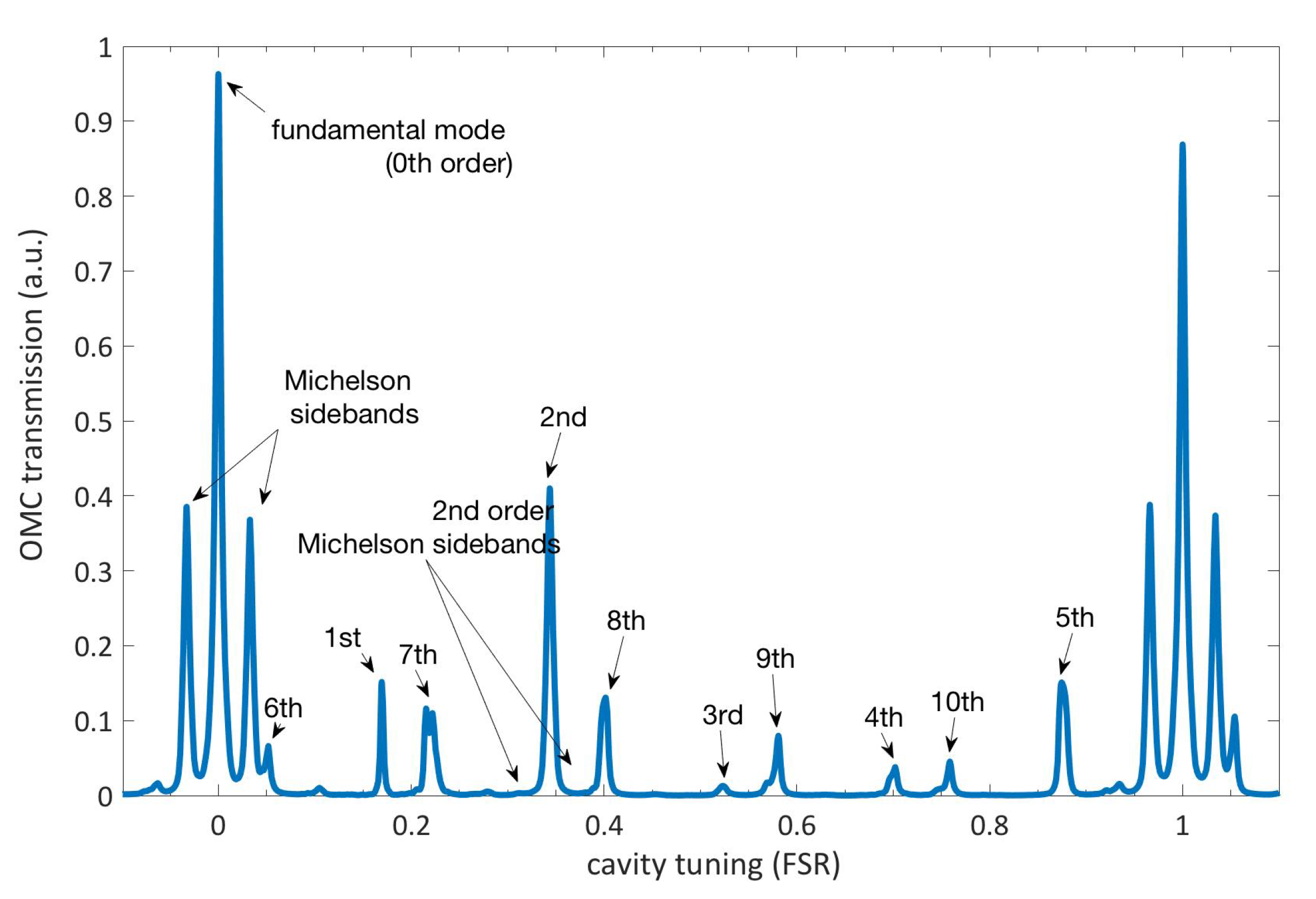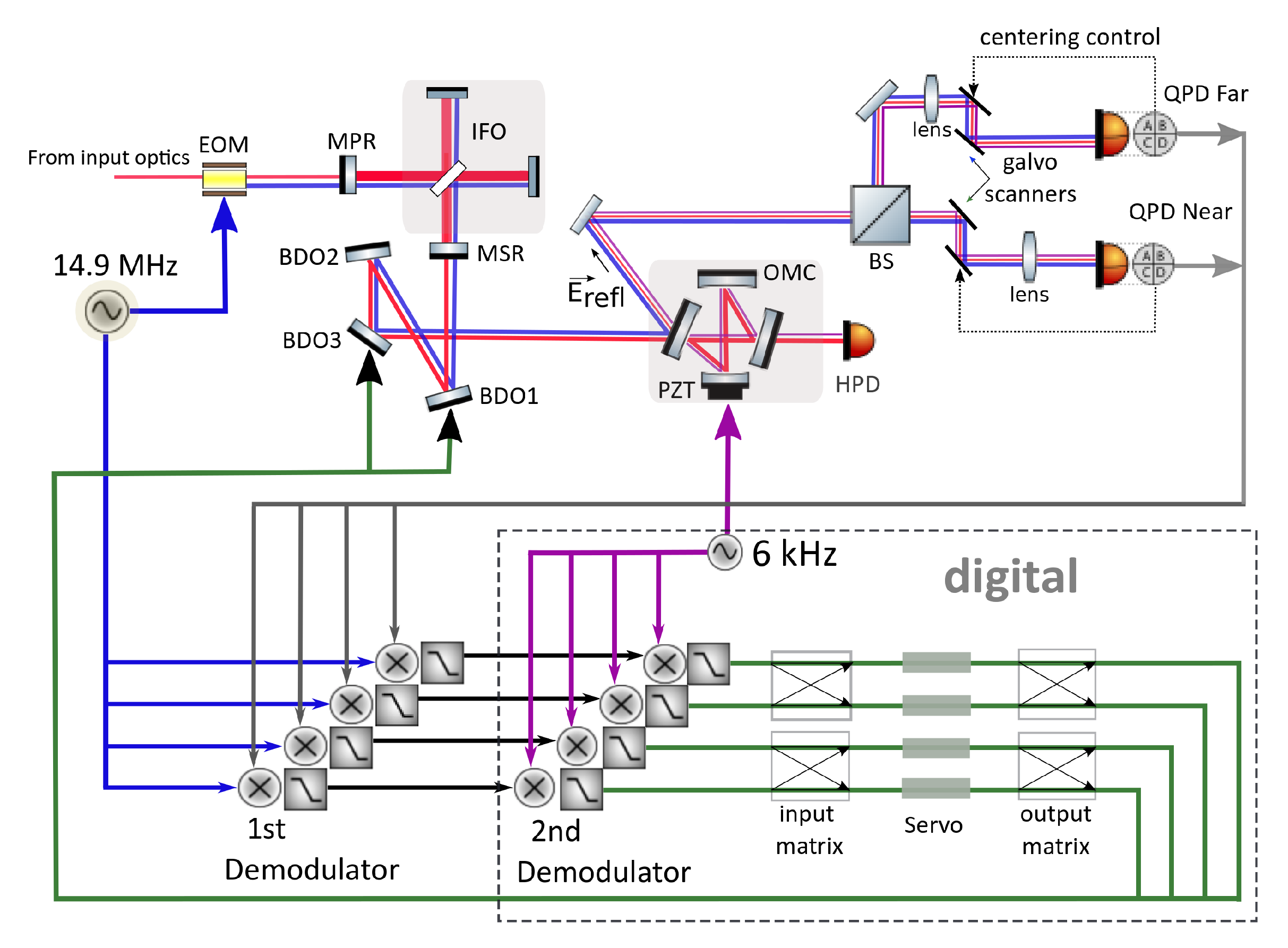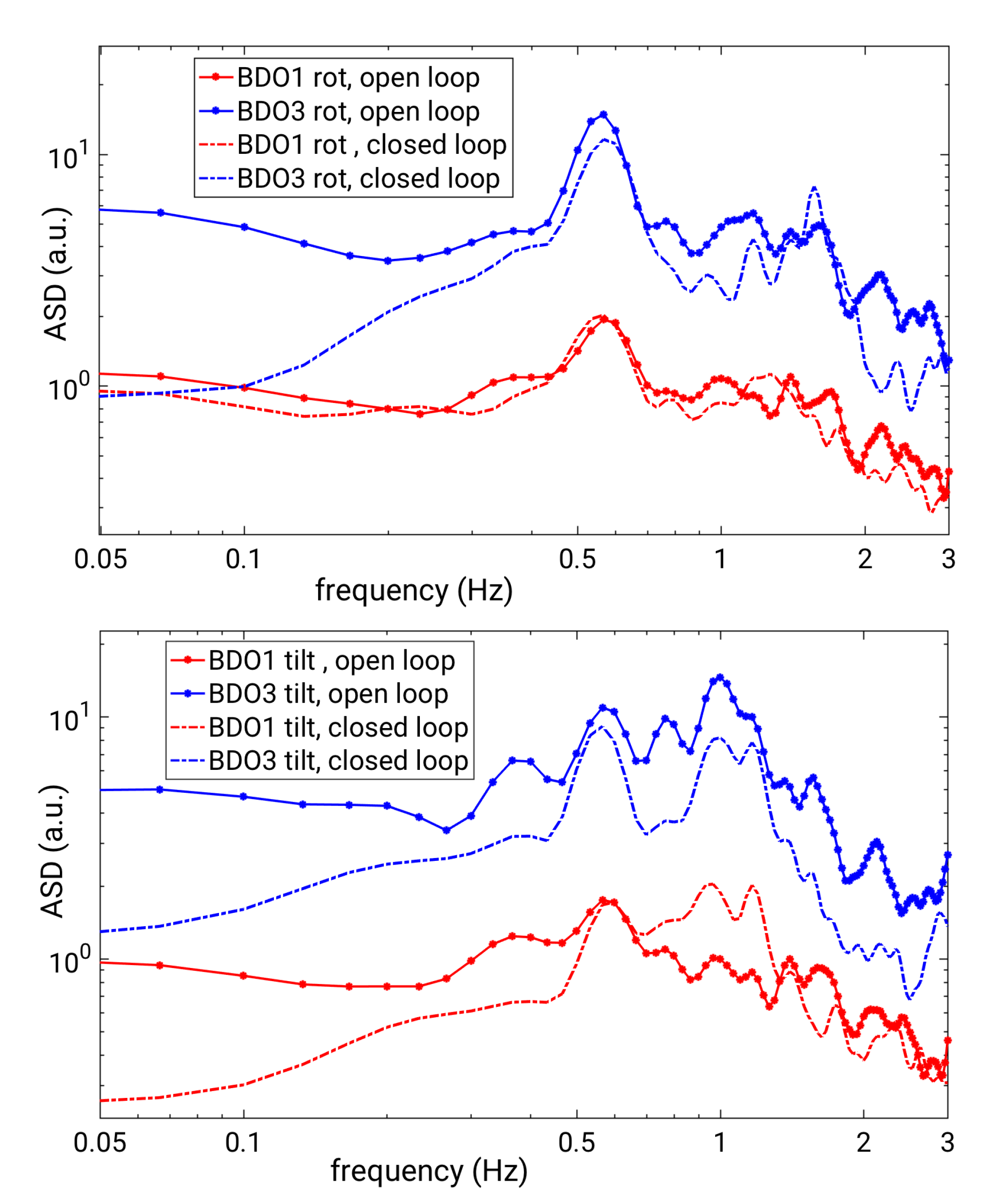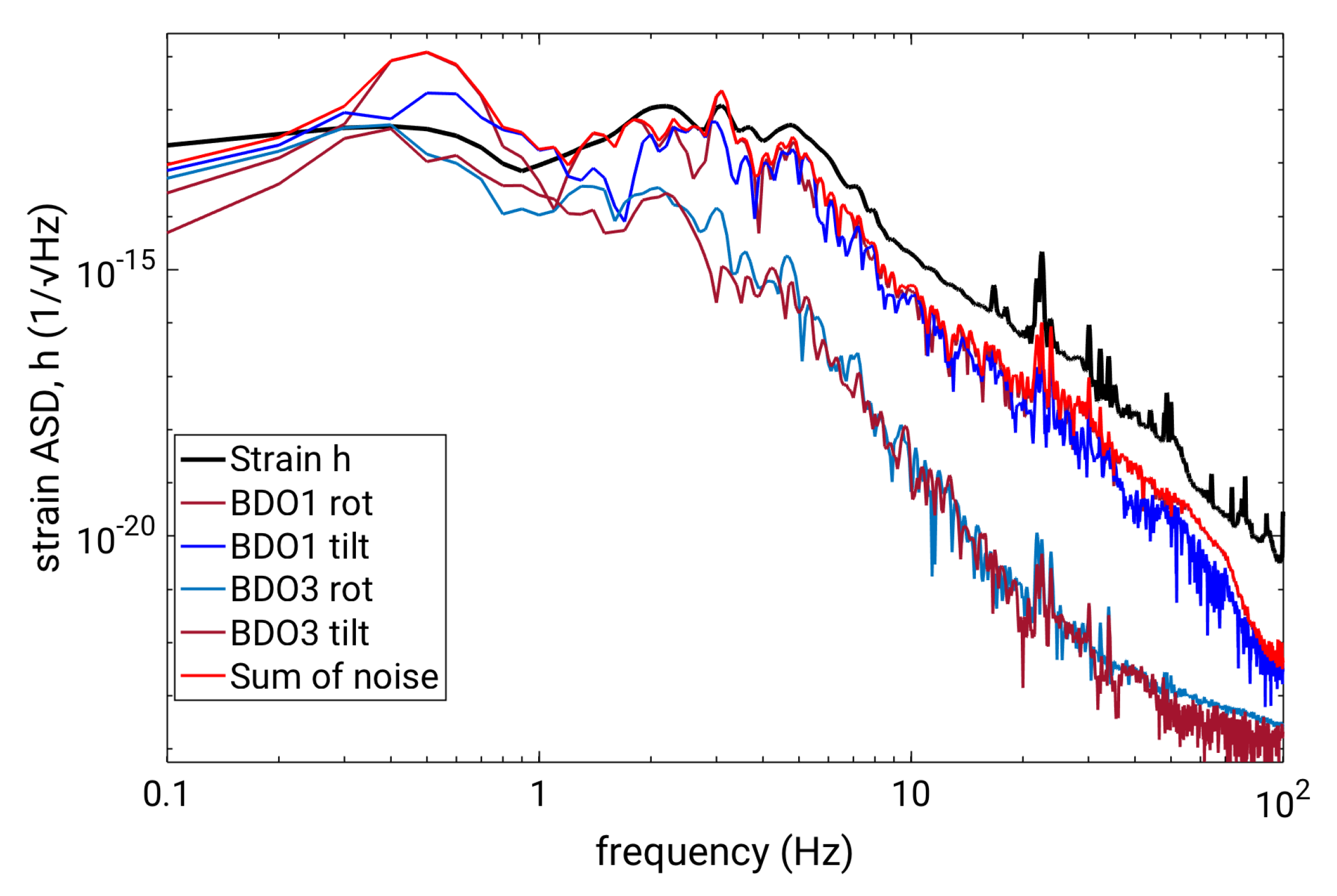Modulated Differential Wavefront Sensing: Alignment Scheme for Beams with Large Higher Order Mode Content
Abstract
1. Introduction
2. Differential Wavefront Sensing Technique
3. Modulated Differential Wavefront Sensing
- (i.)
- The first is a phase modulation at 14.9 MHz, referred to as the MI SBs (), which is done to the MI input beam (see Figure 2). The MI SBs are resonant in the MI along with the carrier, but with a smaller power enhancement factor. Hence, they are predominantly in the mode and serve as a good approximation of the fundamental GW carrying mode [10]. Also, they are promptly reflected by the OMC and can be found in the OMC reflected field.
- (ii.)
- The second modulation at 6 kHz () is done via the PZT attached to one of the mirrors of the OMC. This frequency , modulating the carrier inside the OMC, appears as phase modulation sidebands leaking out through the reflection port of the OMC, thus marking its eigenmode. There is also a component due to the prompt reflection of the carrier at the OMC reflected port, but this does not contain information about the cavity mode. It should be mentioned here that is an already existing modulation used for the longitudinal control of the OMC by the dither locking technique. Therefore, no additional auxiliary modulation is required for MDWS.
4. Measurements and Results
5. Conclusions
Author Contributions
Funding
Acknowledgments
Conflicts of Interest
References
- Grote, H.; Freise, A.; Malec, M.; Heinzel, G.; Willke, B.; Lück, H.; Strain, K.A.; Hough, J.; Danzmann, K. Dual recycling for GEO 600. Class. Quantum Gravity 2004, 21, S473. [Google Scholar] [CrossRef]
- Wittel, H.; Lück, H.; Affeldt, C.; Dooley, K.L.; Grote, H.; Leong, J.R.; Prijatelj, M.; Schreiber, E.; Slutsky, J.; Strain, K.; et al. Thermal Correction of Astigmatism in the Gravitational Wave Observatory GEO 600. Class. Quantum Gravity 2014, 31, 065008. [Google Scholar] [CrossRef][Green Version]
- Schreiber, E. Gravitational-Wave Detection beyond the Quantum Shot-Noise Limit. Ph.D. Thesis, Gottfried Wilhelm Leibniz Universität, Hannover, Germany, 2017. [Google Scholar]
- Wittel, H. Active and Passive Reduction of High Order Modes in the Gravitational Wave Detector GEO 600. Ph.D. Thesis, Gottfried Wilhelm Leibniz Universität, Hannover, Germany, 2015. [Google Scholar]
- Prijatelj, M. Gravitational Wave Detection with Refined Light. Ph.D. Thesis, Gottfried Wilhelm Leibniz Universität, Hannover, Germany, 2012. [Google Scholar]
- Hild, S.; Grote, H.; Degallaix, J.; Chelkowski, S.; Danzmann, K.; Freise, A.; Hewitson, M.; Hough, J.; Lück, H.; Prijatelj, M.; et al. DC-readout of a signal-recycled gravitational wave detector. Class. Quantum Gravity 2008, 26, 5. [Google Scholar] [CrossRef]
- Smith, N. Techniques for Improving the Readout Sensitivity of Gravitational Wave Antennae. Ph.D. Thesis, Massachusetts Institute of Technology, Cambridge, MA, USA, 2012. [Google Scholar]
- Prijatelj, M.; Grote, H.; Degallaix, J.; Hewitson, M.; Hild, S.; Affeldt, C.; Freise, A.; Leong, J.; Lück, H.; Strain, K.A.; et al. Control and automatic alignment of the output mode cleaner of GEO 600. J. Phys. Conf. Ser. 2010, 228, 012014. [Google Scholar] [CrossRef]
- Lough, J.; Schreiber, E.; Bergamin, F.; Grote, H.; Mehmet, M.; Vahlbruch, H.; Affeldt, C.; Brinkmann, M.; Bisht, A.; Kringel, V.; et al. First Demonstration of 6 dB Quantum Noise Reduction in a Kilometer Scale Gravitational Wave Observatory. Available online: https://arxiv.org/abs/2005.10292v1 (accessed on 20 May 2020).
- Affeldt, C.; Danzmann, K.; Dooley, K.L.; Grote, H.; Hewitson, M.; Hild, S.; Hough, J.; Leong, J.; Lück, H.; Prijatelj, M.; et al. Advanced Techniques in GEO 600. Class. Quantum Gravity 2014, 31, 22. [Google Scholar] [CrossRef]
- Drever, R.W.P.; Hall, J.L.; Kowalski, F.V.; Hough, J.; Ford, G.M.; Munley, A.J.; Ward, H. Laser Phase and Frequency Stabilization Using an Optical Resonator. Appl. Phys. B 1983, 31, 97–105. [Google Scholar] [CrossRef]
- Anderson, D.Z. Alignment of resonant optical cavities. Appl. Opt. 1984, 23, 17. [Google Scholar] [CrossRef] [PubMed]
- Morrison, E.; Meers, B.J.; Robertson, D.I.; Ward, H. Automatic alignment of optical interferometers. Appl. Opt. 1994, 33, 5041–5049. [Google Scholar] [CrossRef] [PubMed]
- Morrison, E.; Meers, B.J.; Robertson, D.I.; Ward, H. Experimental demonstration of an automatic alignment system for optical interferometers. Appl. Opt. 1994, 33, 5037–5040. [Google Scholar] [CrossRef] [PubMed]
- Bork, R.; Aronsson, M.; Ivanov, A. aLIGO CDS Real-Time Code Generator (RCG V2.8), Application Developer’s Guide; LIGO-T080135-v9. 2013. Available online: https://dcc.ligo.org/LIGO-T080135/public (accessed on 20 May 2020).
- Grote, H.; The LIGO Scientific Collaboration. The GEO 600 status. Class. Quantum Gravity 2010, 27, 8. [Google Scholar] [CrossRef]
- Smith, J.R. Formulation of Instrument Noise Analysis Techniques and Their Use in the Commissioning of the Gravitational Wave Observatory, GEO 600. Ph.D. Thesis, Gottfried Wilhelm Leibniz Universität, Hannover, Germany, 2006. [Google Scholar]




Publisher’s Note: MDPI stays neutral with regard to jurisdictional claims in published maps and institutional affiliations. |
© 2020 by the authors. Licensee MDPI, Basel, Switzerland. This article is an open access article distributed under the terms and conditions of the Creative Commons Attribution (CC BY) license (http://creativecommons.org/licenses/by/4.0/).
Share and Cite
Bisht, A.; Prijatelj, M.; Leong, J.; Schreiber, E.; Affeldt, C.; Brinkmann, M.; Doravari, S.; Grote, H.; Kringel, V.; Lough, J.; et al. Modulated Differential Wavefront Sensing: Alignment Scheme for Beams with Large Higher Order Mode Content. Galaxies 2020, 8, 81. https://doi.org/10.3390/galaxies8040081
Bisht A, Prijatelj M, Leong J, Schreiber E, Affeldt C, Brinkmann M, Doravari S, Grote H, Kringel V, Lough J, et al. Modulated Differential Wavefront Sensing: Alignment Scheme for Beams with Large Higher Order Mode Content. Galaxies. 2020; 8(4):81. https://doi.org/10.3390/galaxies8040081
Chicago/Turabian StyleBisht, A., M. Prijatelj, J. Leong, E. Schreiber, C. Affeldt, M. Brinkmann, S. Doravari, H. Grote, V. Kringel, J. Lough, and et al. 2020. "Modulated Differential Wavefront Sensing: Alignment Scheme for Beams with Large Higher Order Mode Content" Galaxies 8, no. 4: 81. https://doi.org/10.3390/galaxies8040081
APA StyleBisht, A., Prijatelj, M., Leong, J., Schreiber, E., Affeldt, C., Brinkmann, M., Doravari, S., Grote, H., Kringel, V., Lough, J., Lueck, H., Strain, K., Weinert, M., Wittel, H., & Danzmann, K. (2020). Modulated Differential Wavefront Sensing: Alignment Scheme for Beams with Large Higher Order Mode Content. Galaxies, 8(4), 81. https://doi.org/10.3390/galaxies8040081




